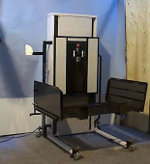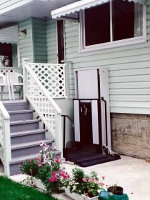The Wheelchair Guide
Your Wheelchair and Mobility Scooter Resource
Wheelchair Lifts, The Inexpensive Elevator Alternative
Tuesday, March 16th, 2010
 Wheelchairs are a powerful tool used to help those who have difficulty walking or getting around. There are many types of wheelchairs, including sports wheelchairs, manual wheelchairs, and electric wheelchairs. While incredibly useful, one common problem among wheelchair users is accessing areas that have staircases. One option to increase accessibility is to use a vertical platform lift.
Wheelchairs are a powerful tool used to help those who have difficulty walking or getting around. There are many types of wheelchairs, including sports wheelchairs, manual wheelchairs, and electric wheelchairs. While incredibly useful, one common problem among wheelchair users is accessing areas that have staircases. One option to increase accessibility is to use a vertical platform lift.
Vertical platform lifts are basically small elevators, but unlike a regular elevator, the unit is entirely self contained. Vertical platform lifts, which are also called porch lifts and wheelchair lifts, are placed next to the landing of a staircase and raise vertically to the top of the landing. Depending on the model, some porch lifts can raise up to 12 feet, which is rather high for a front porch.
Vertical platform lifts are similar to stair lifts, in that they are designed to be used by those who have difficulty using the stairs. However, unlike a stair lift, which only provides a chair or small platform to stand on, it is possible to drive a wheelchair directly onto the vertical platform lift. As a result, they can be used with manual wheelchairs, electric wheelchairs, and even mobility scooters, with most supporting over 500 pounds of weight.
Installing a wheelchair lift is usually very easy, but it requires a sturdy base that is capable of not only supporting the weight of the wheelchair lift, but also the people using it. The base should be made out of concrete or wood and it is very important to consider drainage as well. Proper drainage will prevent water from pooling up under the wheelchair lift, as well as keeping the area around it free from mud or pooled water. It is also important to consider roof water runoff, so it is important to have gutters installed above the wheelchair lift if it is to be installed under an overhang. Also, care should be taken to remove any limbs that may fall on the wheelchair lift during a storm.
Aside from a sturdy base, the only main requirement is that there is enough room next to the landing to install the wheelchair lift. This is because the platform of the wheelchair lift moves vertically from the ground to the landing and back down again, so it must be able to be placed next to the staircases landing. As a result, wheelchair lifts will often not work on interior staircases. In this case, a special platform stair lift is used, which uses a platform attached to a metal track running the length of the staircase to transport the wheelchair user. However, the exception to this rule is in commercial settings, such as schools and churches, where it is often possible to install the wheelchair lift directly next to the staircase’s landing.
Wheelchair lifts offer a very easy and cost effective way of making the home more accessible to wheelchair users, but many people still prefer to use a ramp. The main advantage of a wheelchair ramp is that it is usually considerably less expensive than a wheelchair lift, especially if you build it out of wood.
How to Install a Vertical Platform Lift
Friday, October 16th, 2009

The homeowner built their own gate for this porch lift.
Choosing the Right Location
Before ordering a vertical platform lift, it is important to ensure that you have a place where it can be installed in your home. These devices work by raising a platform straight up in the air to the top of a staircase, so must be placed directly next to the staircase landing. The placement is important, because when the platform of the wheelchair lift is completely raised, the user can drive their wheelchair directly from the landing onto the platform.
It is usually necessary to remove a section of the handrail from the landing. Some porch lifts offer a door that goes in place of the removed handrail, so it is not possible to drive or fall off the landing when the platform is not present. It is also possible to build your own door.
Preparing to Install
Wheelchair lifts require a solid base, which will be able to support both the weight of the lift and anyone that is using it. The best sort of base is one made out of concrete, but a wooden base will also suffice. For temporary installations, it is also sometimes possible to mount the wheelchair lift on a few 2 by 4′s, which are buried in the ground. However, this should only be used temporarily, while a concrete or permanent wooden base is being built.
In addition to providing adequate weight support, the platform should also have adequate drainage, so water does not pool under the lift when it rains. This isn’t usually a problem with wooden bases, but is common in concrete bases. If at all possible, a drain should be installed in the concrete base.
Another consideration is the way the water runs off of the roof, as most wheelchair lifts will be installed partially under the roof overhang. This means that gutters should be installed over the porch lift and they should be kept clean, to avoid water runoff.
Falling tree branches could also cause problems, so if there are any branches overhanging where the lift will be installed, they should be removed prior to installing the wheelchair lift.
An electrical outlet must also be located near the wheelchair lift.
Installing the Wheelchair Lift
Once the prep work is done, the actual installation usually goes very smoothly and quickly. Some wheelchair lifts do not require any assembly at all, but most come in a few pieces. However, even if there is some assembly required, it usually very simple.
After the lift itself has been assembled, it is necessary to move it onto its base. If the base is made out of concrete, it will be necessary to use anchor bolts drilled into the concrete. For wooden bases, it is simply a matter of screwing the bolts into the wood.
Once secured to the base, the wheelchair lift can simply be plugged in and it is ready to go.